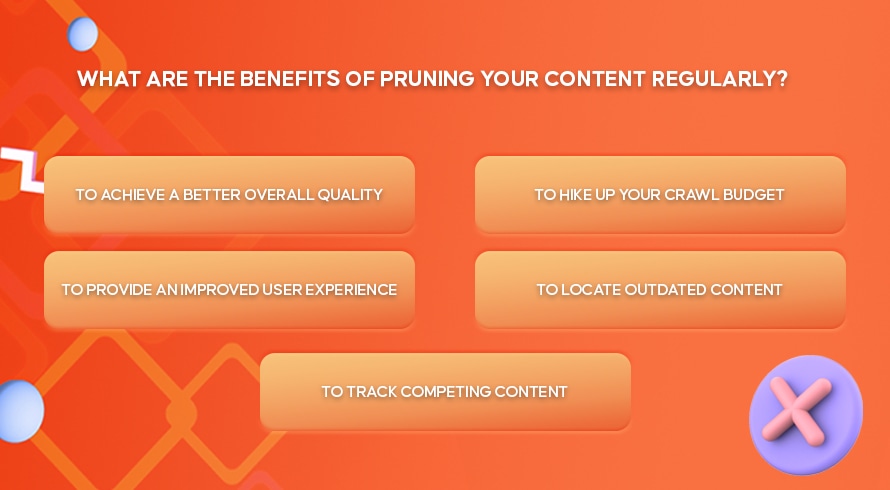Inquivix HQ
1-903, 18 Eonju-ro 146-gil,
Gangnam-gu, Seoul, Korea
06057

Website owners tend to think about new topics, new additions, and effective approaches for their website SEO when creating new articles and pages. However, did you know that the existing pages can also become a considerable factor when improving the SEO of your website? “SEO Pruning” is one such aspect that is used to improve the SEO of a website.
It is true that if existing pages contain low-performing and obsolete information, those can directly harm the SEO of the site, and it is a factor that can harm the Google ranking of the page as well.
Even in life, there is always a time that requires change and refreshment. It is similar to the site’s content as well. When you want to make changes or refresh your site, you can make use of the content pruning process. In this blog, let’s discuss what SEO Pruning is, its benefits, and its process in detail.
What Is SEO Pruning?

SEO Pruning is the process of updating or cutting off content that is unimportant and no longer relevant to the website to support its SEO. It means removing low-performing, outdated content from your site’s archives. For instance, if your website has a post that is written in 2002 about a topic that is lacking timely value in 2022, then you can decide to remove that post considering it a dead post. SEO Pruning is also known as the “Content Pruning Process”.
So, which type of content can you consider irrelevant to a website? Pages that consist of irrelevant information, pages that lack traffic, authority, and engagement, and pages with duplicate content are some of the pages that you can subject to the pruning process.
Wish to learn more ways to optimize your SEO content for blog posts? Chekout our post Content Marketing – How to Optimize Your SEO Content for Blog Posts.
What Is The Purpose Of The Content Pruning Process?
One of the basic reasons that you should conduct content pruning on your website is to clean up the content that has the possibility of harming your site’s SEO. By doing this you can maintain the website’s rankings on Google. On the other hand, SEO pruning is all about eliminating low-traffic content so that your site has more space for new and timely content.
How Often Should You Prune Your Content For SEO?

SEO pruning is a task that you should do regularly. SEO pruning should be a task that you must perform at least every month. When you carry out content pruning regularly, it will always allow you to track the site’s status and performance. The best thing to do is to make it a habit of engaging in content pruning while you work on the content anyway.
Another advantage of regular content pruning is that you will not be left with a huge load of content to be pruned for SEO. Regular content pruning will also give you a relaxed feeling because your site will only include up-to-date posts and therefore, the users will not be navigated to pages with old information. This will indeed give you time to plan other ways of optimizing the site’s SEO.
What Are The Benefits Of Pruning Your Content Regularly?

To Achieve A Better Overall Quality
One of the benefits of regular SEO pruning is the possibility of providing the users of your website with a high-quality experience while they navigate across your site. Regular content pruning will lower the chances of users seeing outdated and irrelevant information on your site.
In addition, the style you use on your site’s posts might differ from the style you had been using at the time you started your site. You might have a more refined style on your posts now when compared to your earlier ones. As a site owner, you do not want your target audience to land on a blog article with such low-quality content. In such instances, content pruning can make you proud of what is on the site already.
To Provide An Improved User Experience
Providing an improved user experience is another reason why you should engage in conducting content pruning regularly. Your prime motive as a site owner is to give the target audience the best experience by providing them with timely and convenient information. Therefore, removing all the unnecessary pages with thin content will help you in providing an improved user experience.
[H3] To Hike Up Your Crawl Budget
Your website must be crawled by Google bots for your site to be indexed and ranked higher by Google and other search engines. Significantly, content pruning helps you in this task. As it is mentioned earlier, extra outdated posts and pages can drag down your site’s index and ranking and therefore, harm your site’s performance in the SERP rankings. The easy way to get rid of this is to conduct content pruning regularly.
To Locate Outdated Content
The most evident benefit of regular content pruning is its ability to locate outdated content in the existing content. If you are a website owner, you already understand the importance of keeping your site up to date. It is a natural phenomenon for older posts to become irrelevant to the present. This process can also be identified as “Content Decay”. Therefore, content pruning will be responsible for eliminating such dead weight and will give the most accurate data to the user.
To Track Competing Content
Another importance of content pruning is its ability to track competing content on your website. Usually, if you own a larger website, the content on your website can be extensive. Therefore, there is scope for duplicate and competing content to exist on multiple pages of your website.
Moreover, if multiple pages include the same keywords or contesting keywords, it can harm the visibility and authority of those competing pages. Through content pruning, such duplicate and competing content can be discovered and resolved as a support to the site.
Content Pruning also focuses on website maintenance. Learn more about website maintenance by reading our blog “Website Maintenance – What Is It and Why Is It so Important?”
What Is The SEO Pruning Process?

Step 01 – Gathering Data To Create An Overview
Your first step is to gather enough data from your site to create an overview of the content on your site. It is important to include all the images, videos, and PDF files on your site. Page views, page value, bounce rate, and external, and internal links are some of the many pieces of data you should collect using Google tools such as Google Search Console, and Google Analytics. With all this data, you can create an overview of all of your content.
Step 02 – Auditing For Underperformed Pages
Once you have an overview of all of your content, the next thing you have to do is to identify the underperforming pages. Usually, you will come across pages that include outdated and unnecessary information and pages with duplicate keywords and information. When you are auditing for underperformed pages you might also identify pages that drop website traffic, authority, and ranking in the SERP results.
Step 03 – The Content Pruning Stage Begins!
This is your final step. In this step, you have to decide what you need to do with the underperforming pages of your website. There are three tasks you can perform when deciding the fate of your content. Either you can improve underperforming content, you can remove outdated content completely, or hide useless content and make it non-indexable.
Not all your underperforming pages need to be removed. Sometimes, there will be pages that can be rescued and improved to increase the SEO performance. On such occasions, it is always best to work on those pages by refining the titles, meta descriptions, and/or headings, refining and adding new sections, and by erasing obsolete parts.
Removing old posts and irrelevant information such as old announcements and events can be done at this stage. Before removing, it is best if you can check for valuable information that needs to be recorded offsite, or else, you can try to merge them with another existing post. Most importantly, if you decide to remove a post, never forget to redirect the URL to the equivalent page. Or else, the users will be directed to a non-existing page and create an awful experience for them.
Another option you can consider in content pruning is hiding posts or pages from getting detected for indexing and ranking. On occasions where the content is purposeless for search engines but useful for your audience, you can select the option of hiding that page from the search engines.
Improve The Quality Of Your Content With Inquivix

It takes so much effort to come up with best practices to maintain high-quality content. Now you know that websites are not always about adding new content. It is also about fine-tuning what is already on the website. As you can see, pruning is not always about completely removing content. Content pruning also involves improving underrated pages and hiding not-so-important posts. In short, content pruning is a regular process that you need to carry out if you wish to outshine your best and newest content and make your website survive in the long run.
An SEO pruning campaign will not only facilitate your Google rankings, but it is indeed an effective content marketing strategy. If all of this sounds daunting and like a lot of work, Inquivix is here to assist you with all your content management requirements.
Click here and contact us today and learn more about what makes our digital marketing services more prominent.
FAQs
SEO Pruning is the process of updating or cutting off content that is resourceless and no longer relevant to the website to support its SEO. For instance, if your website has a post that is written in 2002 about a topic that is lacking timely value in 2022, then you can decide to remove that post considering it a dead post. SEO Pruning is also known as “Content Pruning”.
SEO pruning should be a task that you must perform at least every month. The reason is when you carry out content pruning it will always be possible for you to track the site’s status and performance. Moreover, regular content pruning will give you easy access because your site will only include up-to-date posts.
